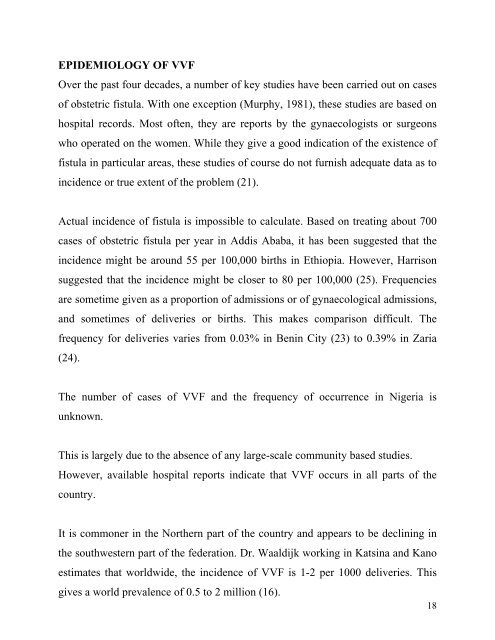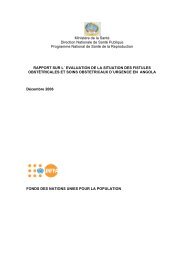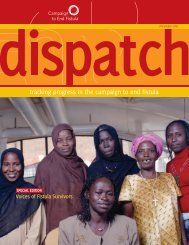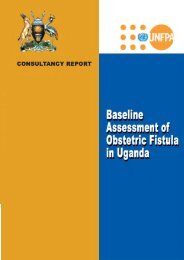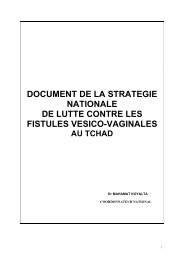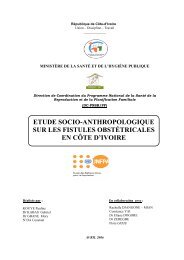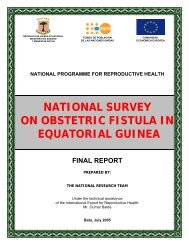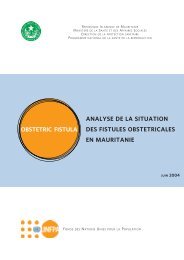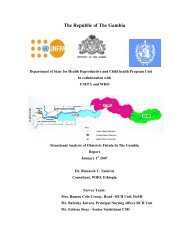report of the rapid assessment of vesico-vaginal fistulae in nigeria
report of the rapid assessment of vesico-vaginal fistulae in nigeria
report of the rapid assessment of vesico-vaginal fistulae in nigeria
Create successful ePaper yourself
Turn your PDF publications into a flip-book with our unique Google optimized e-Paper software.
EPIDEMIOLOGY OF VVFOver <strong>the</strong> past four decades, a number <strong>of</strong> key studies have been carried out on cases<strong>of</strong> obstetric fistula. With one exception (Murphy, 1981), <strong>the</strong>se studies are based onhospital records. Most <strong>of</strong>ten, <strong>the</strong>y are <strong>report</strong>s by <strong>the</strong> gynaecologists or surgeonswho operated on <strong>the</strong> women. While <strong>the</strong>y give a good <strong>in</strong>dication <strong>of</strong> <strong>the</strong> existence <strong>of</strong>fistula <strong>in</strong> particular areas, <strong>the</strong>se studies <strong>of</strong> course do not furnish adequate data as to<strong>in</strong>cidence or true extent <strong>of</strong> <strong>the</strong> problem (21).Actual <strong>in</strong>cidence <strong>of</strong> fistula is impossible to calculate. Based on treat<strong>in</strong>g about 700cases <strong>of</strong> obstetric fistula per year <strong>in</strong> Addis Ababa, it has been suggested that <strong>the</strong><strong>in</strong>cidence might be around 55 per 100,000 births <strong>in</strong> Ethiopia. However, Harrisonsuggested that <strong>the</strong> <strong>in</strong>cidence might be closer to 80 per 100,000 (25). Frequenciesare sometime given as a proportion <strong>of</strong> admissions or <strong>of</strong> gynaecological admissions,and sometimes <strong>of</strong> deliveries or births. This makes comparison difficult. Thefrequency for deliveries varies from 0.03% <strong>in</strong> Ben<strong>in</strong> City (23) to 0.39% <strong>in</strong> Zaria(24).The number <strong>of</strong> cases <strong>of</strong> VVF and <strong>the</strong> frequency <strong>of</strong> occurrence <strong>in</strong> Nigeria isunknown.This is largely due to <strong>the</strong> absence <strong>of</strong> any large-scale community based studies.However, available hospital <strong>report</strong>s <strong>in</strong>dicate that VVF occurs <strong>in</strong> all parts <strong>of</strong> <strong>the</strong>country.It is commoner <strong>in</strong> <strong>the</strong> Nor<strong>the</strong>rn part <strong>of</strong> <strong>the</strong> country and appears to be decl<strong>in</strong><strong>in</strong>g <strong>in</strong><strong>the</strong> southwestern part <strong>of</strong> <strong>the</strong> federation. Dr. Waaldijk work<strong>in</strong>g <strong>in</strong> Kats<strong>in</strong>a and Kanoestimates that worldwide, <strong>the</strong> <strong>in</strong>cidence <strong>of</strong> VVF is 1-2 per 1000 deliveries. Thisgives a world prevalence <strong>of</strong> 0.5 to 2 million (16).18


